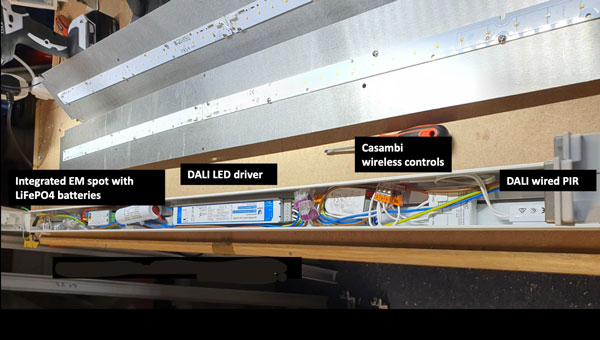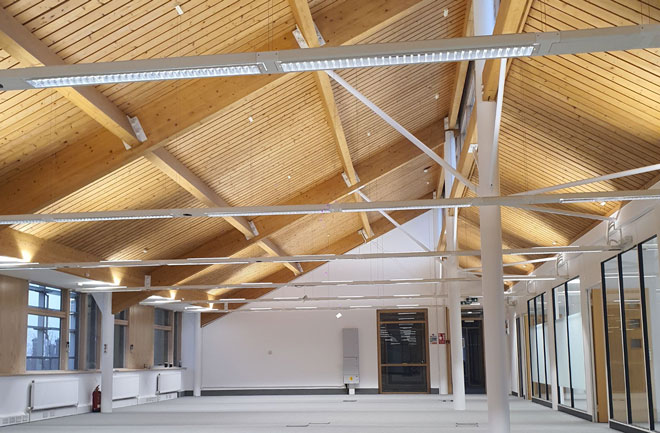THE BUILDING Research Establishment has reused all its existing light fittings in a major upgrade of the lighting at its headquarters in Watford, UK.
The fluorescent-to-LED refurbishment project saved 252 kilograms of luminaires’ bodies from removal and resulted in energy savings of up to 45 per cent and increases of light output to up to 35 per cent.
Lighting firm Silent refurbished 180 28W T5 fluorescent continuous linear suspended linear lights, 52 twin 18W PL fluorescent downlights, 16 40W T5 round fluorescent bulkheads and nine twin 40W PL 600 x 600 recessed modulars.
The lighting was originally controlled by a Philips Helios system with integrated PIRs. Silent replaced this with a DALI lighting control system run on a wireless Casambi platform.
Most lights were up and downlight which presents a challenge for LED as they required LED boards pointing up and down. This required a new heatsinking aluminium plate to be made up to facilitate this.
Additionally, the LED boards needed to be enclosed to prevent being touched as they were running at 75V DC.

Silent used a Tridonic ACL lens cover to provide this level of protection and allow ease of maintenance in the future as these simply clip onto the LED board screws.
The fitting were then tested photometrically after being retrofitted with the LEDs. This was carried out by LUX TSI in Wales so that the suppliers could prove output and provide lighting calculations.
For emergency lighting, Silent decided to integrate a dedicated EM spot to give 110 degree coverage compared to the 65 degree that the louvre would have given.
This allowed the company to use about half the required emergency lighting and associated battery packs which in turn reduced the environmental impact of the retrofit considerably.
The wide emergency spotlight delivered 450 lumens. LiFEPO4 lithium ion batteries were used for long service life
The original track used 18W PL lamps. These were replaced with 10 watt CREE LED chip and a custom heatsink. Again, Casambi wireless controls were used with integrated PIRs.
For the linear lighting, the LED boards run at 350mA current and deliver 3,700 lumens of light output with a power consumption of 21W. This is a 900 lumen increase in output and a 30 per cent reduction in energy consumption. With 180 lights, that’s a 1.260 kWh saving every hour of running.
Additionally, the LED Boards are rated at a 60,000 hours lifetime against 30,000 hours for the fluorescent tubes they replace.
For the track lights the energy savings is 45 per cent less consumption for the 10W LED lamp and a 35 per cent increase in light output versus the PL lamp it replaces.
The LED chip will also last a minimum of 50,000 hours versus the 8,000 hours the PL fluorescent lamp does.
Some 92Kg of waste was removed from the site. This comprised lamps, ballasts and internal wiring. Some 252Kg of waste in the form of the existing lighting bodies was prevented from removal by their reuse.
Finally, 216 meters of plastic diffuser saved by not using new lighting.

